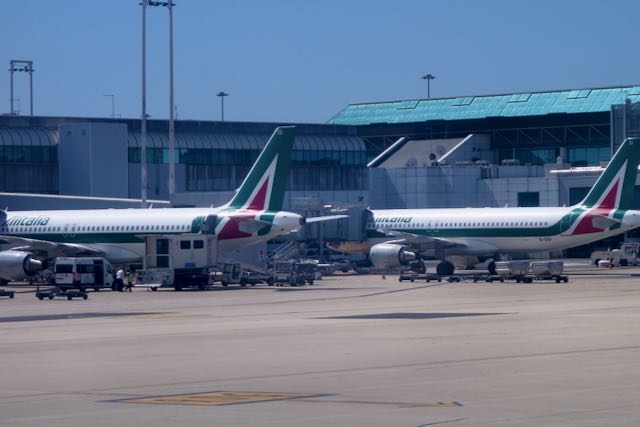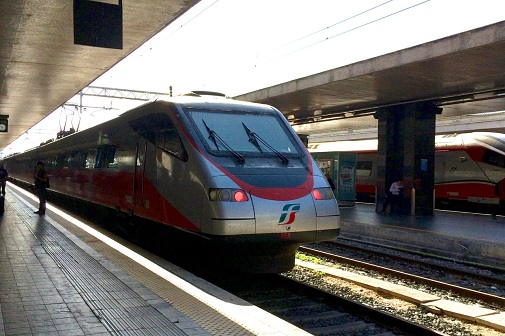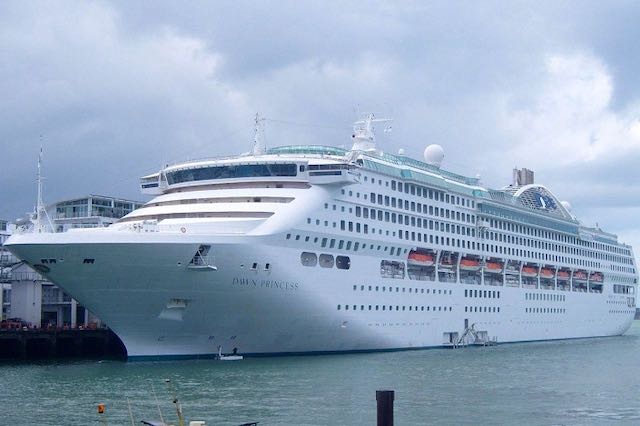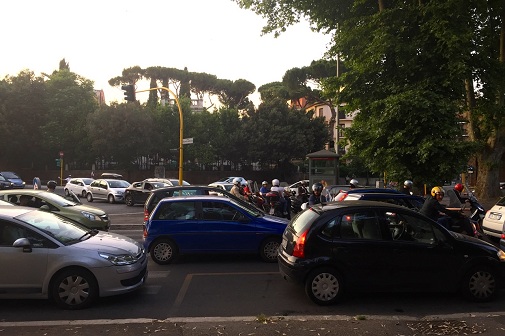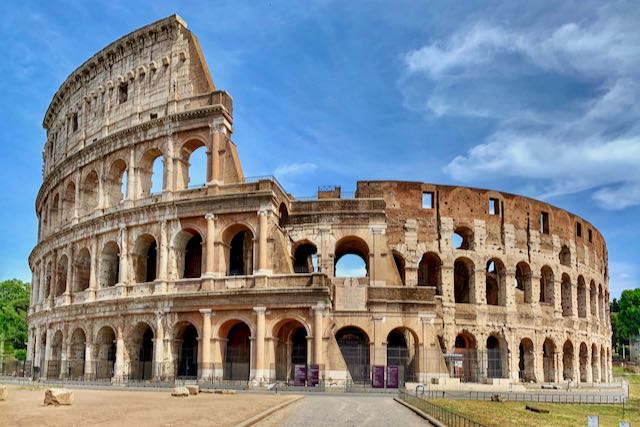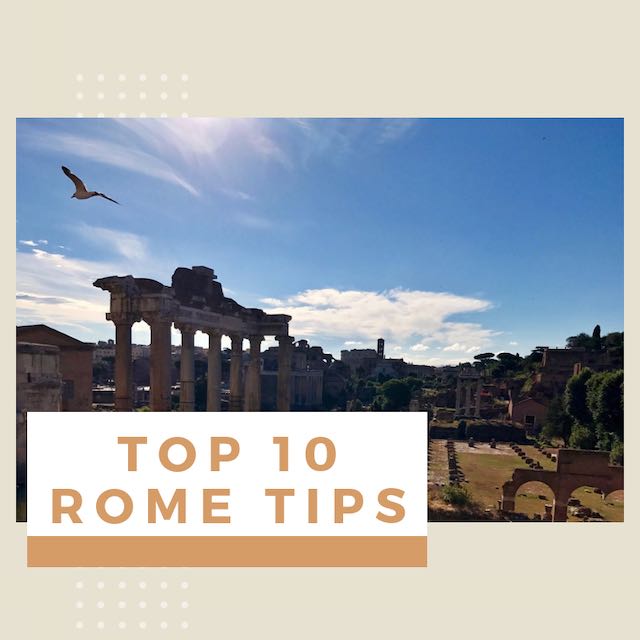- Sign up & get a FREE ebook Subscribe NOW!
- Romewise Home Page
- Getting to Rome
Making Traveling To Rome Easy - Our Complete Guide On How To Reach The Eternal City
There are all sorts of options for traveling to Rome, whether you’re coming from within Italy, Europe or further afield.
Over the years I’ve taken every form of transport available to reach Rome, so whether you're flying, driving, taking the train or stopping on a cruise, my guide lays out all your options for getting into the city.
Everything You Need to Know About Traveling to Rome
Even if you have flights or a cruise booked already, there are some additional steps to follow in order to get into the heart of Rome.
In this guide I will be talking about all the different travel options so you can choose the right one for you, including:
- Flying to Rome
- Traveling to Rome from Fiumicino airport
- Reaching Rome from Ciampino airport
- Taking the train to Rome
- Stopping at Rome on a cruise
- Bus and coaches to Rome
- Driving to Rome
Traveling to Rome by Plane
If you're traveling to Rome by plane, the two main things you need to know are, which airport to fly into and then how to get into the city center from that airport.
Airports in Rome
There are two airports in Rome: Fiumicino (Leonardo da Vinci) and Ciampino.
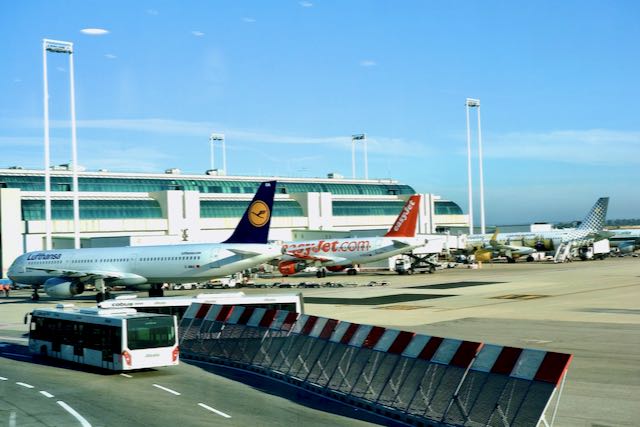 If you're traveling to Rome by plane, you should know we have two airports in Rome, Fiumicino and Ciampino.
If you're traveling to Rome by plane, you should know we have two airports in Rome, Fiumicino and Ciampino.Fiumicino airport is the main Rome international airport, and one of the largest in Europe. The majority of flights to Rome land and take off from here, including long-haul flights, so most people transit through at some point during their trip.
Ciampino used to be a military airport, so it is much smaller. Today it is a hub for many of the low-cost airlines that fly to Rome from European and short-haul destinations. So, if you’re traveling around Europe, you may well fly into Ciampino.
Both airports are run by the same organization, ADR, so you can find lots of helpful information about the different services offered at both on their official website.
Fiumicino is around a 45 minute drive into the center of Rome and Ciampino is around 30 minutes drive, but there are more extensive connections at Fiumicino so the actual transfer time is not really that different.
Which Rome Airport Should You Use?
Both airports are consistently highly rated and offer a good range of services. Fiumicino is much larger and so has a lot more for people traveling through, but Ciampino is not a bad option.
They have done a lot of renovation work in recent years, so when I took a flight out last year I was pleasantly surprised at how nice it was.
If you have multiple flight options and aren’t sure which one to book, my advice would be to look at the arrival times.
If you have a flight that arrives in Fiumicino very early or very late and another that lands at Ciampino at a regular time, I would opt for the Ciampino flight. You are more likely to find closed stores and service desks at unusual times which can be frustrating when you arrive tired and jet-lagged.
If the Fiumicino flight does arrive at a regular point in the day, I would go for that one. This is because there are more connection options into the city center and more services available if you want something to eat or need assistance.
With both airports, the most important thing is to have planned your route from the airport to Rome city center before you land.
Travel Documents
Before traveling to Rome, Italy or anywhere in the EU, you should double check your passport validity.
In order to enter an EU country from a non-EU location, your passport need to be valid for at least 3 months AFTER the date you plan to leave the EU, as well as being issued less than 10 years before the the date you ENTER the EU.
In practice, your passport needs to be valid for at least 6 months before traveling, in order to give yourself enough of a buffer.
Consider renewing your passport early if you're getting close to your expiry date.
How to Get From Fiumicino Airport to Rome City Center
You have lots of options for traveling between Fiumicino airport and the center of Rome, ranging from coach services to private transfers.
Whichever option you choose, I highly recommend booking in advance for peace of mind and knowing your transportation is sorted and pre-paid before you arrive.
By Coach
Option one is the coach/bus services. These are run by a few different companies, and end at Roma Termini, the main train station in Rome. Some also stop near the Vatican as well.
This is the cheapest travel option, costing less than 20€ for a return ticket per person (you can also purchase a single ticket if you only need to go one way). Buses leave from stops up to the right of Terminal 3 when you walk outside.
While you can purchase tickets in person when you arrive, purchasing online is my recommendation as this ensures you get a seat.
The journey time is around 1 hour, but is dependent on city traffic.
By Train
The next option is the train. When you walk outside of the terminals, there are lots of signs for the Fiumicino airport train station, located across from where all the taxis are lined up.
At the train station you can take either the Leonardo Express train or the regular regional trains into Rome.
The regional trains take a little longer and stop at other places before Roma Termini, but they are cheaper. The Leonardo Express goes directly to Roma Termini without stopping, taking around 30 minutes.
By Taxi
The one option you cannot pre-book is the regular taxi to Rome. Taxis line up outside the airport, there is an organized queue and then you get in the taxi when it is your turn. This line moves pretty fast but at busy times you could be waiting for a while.
Prices are fixed for certain destinations, including within the Aurelian walls in the city, specific train stations, Ciampino airport and the cruise port at Civitavecchia - these are updated periodically so check the current fares here.
Never accept a ride from someone outside of the official airport taxi queues, or get in a car that is not an official, licensed taxi.
There is an Uber pick up area, located in one of the parking structures, but Ubers are expensive and unreliable at the airport in my experience.
By Private Transfer
If you are traveling in a larger group or with children, need additional assistance or want to ensure you aren’t waiting around for a regular taxi or coach, booking a private transfer is the best option.
This is my preferred method of traveling to Rome now. I book with trusted providers and know that they will be waiting for me when I have collected my luggage. It just makes travel that much easier.
Private transfers are more expensive than regular taxis but the drivers are allowed to come into the terminal to meet you and help with luggage.
They will also track your flight so can adjust their timings if you are delayed (within a reasonable window), and are more reliable if you are traveling very early or very late in the day.
How to Get From Ciampino Airport to Rome City Center
If you fly into Rome's smaller airport, Ciampino, you have plenty of options for getting into the city, from the bus to public transportation and taxis.
By Coach
There are a number of coaches that go between Ciampino airport and Roma Termini, and this is definitely the cheapest option. Return tickets are under 15€ per person and run around every 20 minutes.
There are three companies who offer this service and tickets are not interchangeable, but they are all essentially the same. Make sure to pre-book your ticket to ensure you get on the bus you want.
By Train
There is no station at Ciampino airport itself. However you can take a local bus to either the Ciampino train station where you can connect with regional trains, or to Roma Anagnina where you can connect to Metro Line A.
Because of all the stages involved, this is not a great option if you have a tight schedule or will have lots of luggage.
By Taxi
Taxis queue up outside Arrivals for you to take into the city. Fares are fixed in the same way as with Fiumicino (check current rates here) and are slightly cheaper because the distance is less.
As always, do not accept rides from people soliciting business away from the official taxi queue.
By Private Transfer
Traveling to Rome from Ciampino is much easier with a private transfer. The drivers track your flight so there is no waiting around and they can help with luggage, child car seats and mobility assistance as you can communicate your needs when booking.
Private transfers do not have fixed fares but prices are generally reasonable and if you’re traveling in a larger group, work out better than taking multiple regular taxis.
Traveling to Rome by Train
Train travel in Italy is easy and comfortable. Both regional and high speed trains are high quality and a great way to get around within Italy.
The trains are therefore one of the most common ways of traveling to Rome if you’re coming from Florence, Naples, Venice or other Italian locations.
Roma Termini Train Station
When traveling to Rome by train, you will likely arrive at Rome's main train station, Termini.
There are other Rome stations, including Roma Tiburtina, Roma Trastevere and Roma Ostiense, so depending on where you are staying, one of these may be a better destination than Roma Termini.
Roma Termini is the main transport hub for the city, with a large bus station outside, taxi ranks, regional and high speed train connections and is where the two Metro lines cross over too.
The station itself has undergone a huge improvement program in recent years so now has lots of places to shop and eat while you wait for your train, as well as lounges and train company service desks.
Booking Train Tickets
You can purchase train tickets in person on the day of travel but if you’re traveling on the popular routes between the big cities, you do not want to do this.
Seats are assigned when you purchase tickets so when all the seats are full, you cannot buy a ticket. Prices are also more expensive when booking last minute tickets.
Most trains are run by Trenitalia, the state railway company, but some of the high speed trains are run by Italo. There is no significant difference between them, so if you’re looking at train options, the main things to check are if the train is direct and if it is high speed or not.
I always use Trainline to look at all my options as it brings together all routes from both companies in one place. You can also see prices and save your tickets ready to be scanned when you start your journey.
Ready to plan your trip?
Book your train
Planning to travel between cities in Italy and other parts of Europe?
Use Trainline to see all the different options available across the different rail companies.
Find your hotel
Find your perfect place to stay in Rome.
Use Booking.com to choose between hotels, guesthouses, and self-catering apartments in neighborhoods throughout the Eternal City.
Buy your TurboPass
Purchase the convenient Turbopass and visit all of Rome's top attractions including the Colosseum, Pantheon, and Vatican.
With one handy pass, it's all included.
Stopping at Rome on a Cruise
If you are traveling to Rome on a cruise, you will be arriving or departing at the port town of Civitavecchia, which is about 80 km (50 miles), or just over an hour’s drive outside of Rome.
Depending on whether your cruise is starting or ending at Rome, or if Rome is a stop on the cruise itinerary, you have a few options for reaching Rome city center.
You can take the train from Civitavecchia station to Roma Termini, which takes around an hour. The station is a bit of a walk from the port, depending on where your ship docks, but there is a free bus shuttle service you can take to make it easier.
If you have a lot of luggage this is not the best option, but is good if you are doing a day trip to Rome.
The other option is to take a taxi. You may be able to get one at the port, but it is far better to book a transfer in advance as there aren’t always many taxis waiting.
This is definitely my recommendation if you are starting or ending a cruise to make managing your luggage easier.
You can also take a taxi or transfer to one of Rome’s airports if you are flying straight out - there is no direct public transport option between Civitavecchia and Fiumicino or Ciampino.
No matter what season you visit Rome, here are 4 essential things we recommend never leaving home without:
Disclosure: If you make a purchase through a link on this page, I may receive a small commission - at no extra cost to you. Thank you for supporting my site!
Traveling to Rome by Bus
Bus and coach travel in Italy is very easy, and sometimes it's more direct to travel to Rome by bus than by train, depending on where you are coming from.
For example, traveling between Sorrento and Rome requires two different trains, but there is a direct bus service between the two locations.
If you are traveling to Rome by coach, you will usually arrive at Roma Tiburtina station, which has a large bus depot. Roma Termini only has local city buses, so if you’re wanting to make connections there, coach travel may not be the best option.
Once you arrive at Tiburtina, you can take a city bus, the Metro or a taxi to your final destination.
These buses are pretty comfortable, and depending on the journey length will stop once or twice for people to use the bathroom and have a short break. They are also reasonably priced, but are at the mercy of traffic so service times are not guaranteed.
If you are traveling on a budget, don’t have lots of luggage and don’t have time restrictions, buses can be a good option.
Driving into Rome
To be frank, I do not recommend traveling to Rome by car.
Driving in Rome is often hectic, stressful and confusing. I have lived here for years and I still prefer to take public transportation or walk where I can.
There are also lots of areas in the center where you cannot drive in a rental car without incurring large fines (which will catch up to you), parking is a challenge and people walk out into the road whenever they see a potential gap for them to cross.
So, if you can avoid bringing a car into Rome, you should definitely try to do so.
If you have been using a rental car elsewhere in Italy, I recommend dropping it off at Fiumicino airport (where all the major companies have offices) and then getting into the city using one of the methods outlined above.
If you do need to drive into Rome, you will not be able to use it to get around the city.
So, check with your hotel or apartment rental to find out the best parking location relative to where you will be staying. Street parking is sometimes available, but you should not rely on this option.
Romewise's Top Travel Resources
Ready to book your trip to Rome? Take a look at these helpful links to companies we use and trust:
- Keep your travel spending simple with the Wise card, which removes all the worry about exchange rates and high transaction fees all over the world
- Search for and book your perfect accommodation
- Our complete guide to what to pack for Rome
- The number one travel accessory, a multi-point travel adapter and voltage converter
- Browse a huge range of tours in Rome and beyond
- Experience unique tours and special access to Rome's most popular sights
- Protect yourself with comprehensive travel insurance
Within this post there are some affiliate links for products and services. For more details about our affiliate policy click here.
Get your 100% free Rome trip planner now!
Simply sign-up today for our free newsletter and get the Romewise Quick Start guide to Rome:
We are committed to respecting your data. Click for our Privacy Policy.
Comments? Questions? Suggestions?
Please come over to the private Romewise Facebook group and join in the conversation.
You will often find me there, happy to answer your questions / comments!
You will also meet other Rome lovers and experts, too.
What are you waiting for?
- Romewise Home Page
- Getting to Rome

